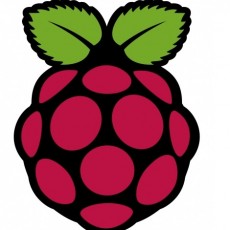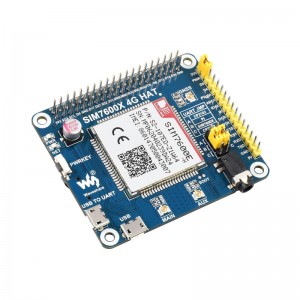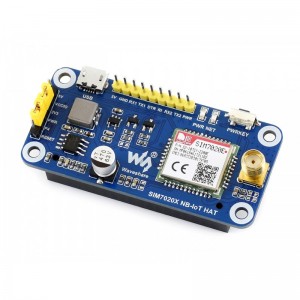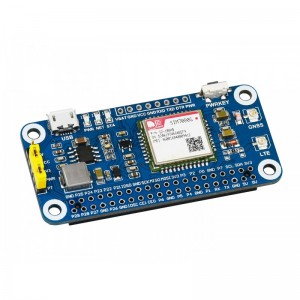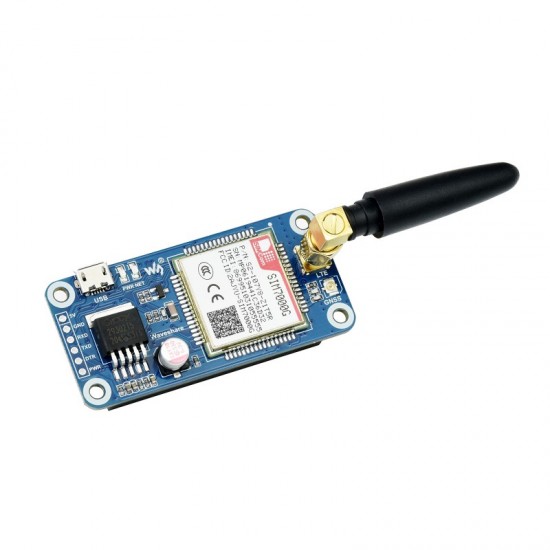
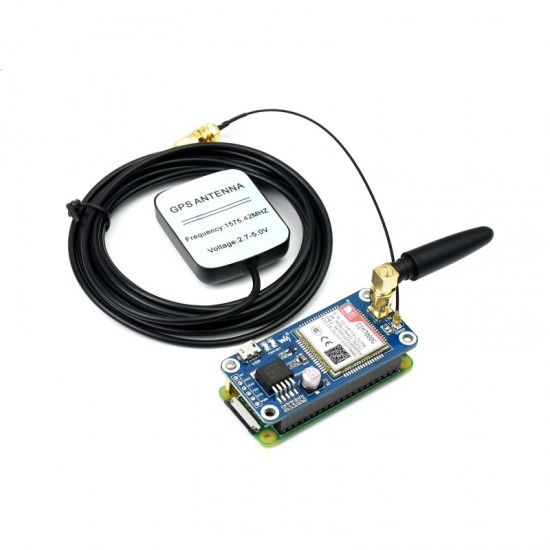
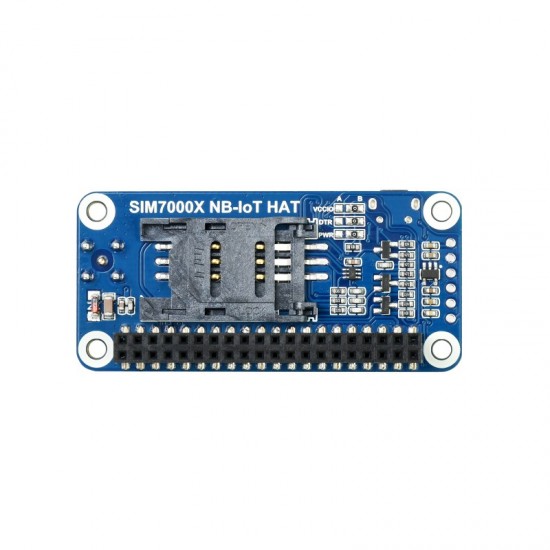

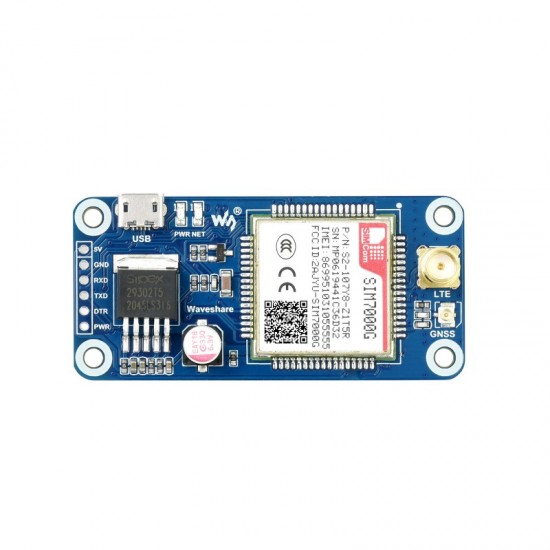





WaveShare Electronics
₹2,234.00 + 18% GST
B2B GST Credit Available
SIM7000G NB-IoT / Cat-M / EDGE / GPRS HAT for Raspberry Pi, GNSS, Global Band Support
This product qualifies for Free Surface Shipping !
All orders with value above 1999+GST are eligible for free delivery in Surface mode. (Not applicable for B2B offline orders)
₹2,636.12
All Inclusive, Shipping Calculated at Checkout
Assured Cashback of ₹ 22
B2B GST Credit Available
- Stock: 1 in Stock
- SKU: 20681
- Delivery Time
- Bulk & B2B RFQ
This is a telecommunication HAT for Raspberry Pi which supports global bands of NB-IoT, Cat-M, and GPRS, as well as GNSS positioning function. Due to its advantages like small size, low delay, and wide coverage, it is the ideal choice for IoT applications such as intelligent instruments, asset tracking, remote monitoring, e-health, and so on.
Features
- Standard Raspberry Pi 40PIN GPIO extension header, supports Raspberry Pi series boards
- Supports TCP, UDP, PPP, HTTP, FTP, MQTT, SMS, Mail, etc.
- Supports GNSS positioning (GPS, BeiDou, GLONASS)
- Onboard USB interface, to test AT Commands, get GPS positioning data, and so on
- Breakout UART control pins, to connect with host boards like Arduino/STM32
- Onboard voltage translator, 3.3V by default, allows to be switched to 5V via 0Ω resistor
- SIM card slot, compatible with both normal SIM card and NB-IoT specific card
- 2x LED indicators, easy to monitor the working status
- Baudrate: 300bps~3686400bps (115200bps by default)
- Control via AT commands (3GPP TS 27.007, 27.005, and SIMCOM enhanced AT Commands)
- Supports SIM application toolkit: SAT Class 3, GSM 11.14 Release 98, USAT
- Comes with development resources and manual (examples for Raspberry Pi/Arduino/STM32)
Resources
Specifications
| NB-IOT / CAT-M / 2G | |
|---|---|
| Frequency bands | NB-IoT: B1, B2, B3, B4, B5, B8, B12, B13, B17, B18, B19, B20, B25, B26, B28 |
| Cat-M: B1, B2, B3, B4, B5, B8, B12, B13, B17, B18, B19, B20, B25, B26, B28, B39 | |
| GPRS/EDGE: 850, 900, 1800, 1900MHz | |
| Data rate | NB-IoT: 34(DL)/66(UL) |
| Cat-M: 300(DL)/375(UL) | |
| EDGE: 236.8(DL)/236.8(UL) | |
| GPRS: 85.6(DL)/85.6(UL) | |
| SIM card support | NB-IoT: NB Specific (Not Included) |
| Cat-M/GPRS/EDGE: Normal SIM (Not Included) | |
| Applicable region | Global |
| GNSS | |
| Satellite systems | GPS, BeiDou, GLONASS |
| Receiver type | 16-channel |
| C/A Code | |
| Sensitivity | Tracking: -162 dBm (GPS) / -157 dBm (GLONASS) / TBD (BD) |
| Cold starts: -148 dBm | |
| Time-To-First-Fix | Cold starts: <35s |
| Hot starts: <1s | |
| Accuracy | Position: <2.5m CEP |
| OTHER | |
| Power supply | 5V |
| Operating voltage | 5V / 3.3V (3.3V by default) |
| Sleep Mode current | 1.2mA (@DRX=2.56s) |
| Power Save Mode current | 9uA |
| Operating temperature | -40°C ~ 85°C |
| Storage temperature | -45°C ~ 90°C |
| Dimensions | 30.2mm x 65mm |
Onboard Peripherals
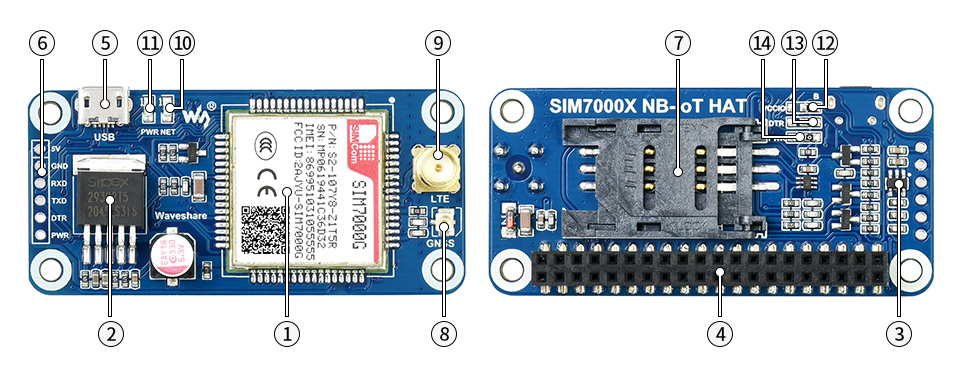
- SPX29302 power chip
- RT9193-33 power chip
- Raspberry Pi GPIO header
for connecting with Raspberry Pi - USB interface
for testing AT Commands, getting GPS positioning data, etc. - SIM7000G control interface
for connecting with host boards like Arduino/STM32 - SIM card slot
supports 1.8V/3V SIM card - GNSS antenna connector
- LTE antenna connector
- Network status indicator
- Power indicator
- Operating voltage selection jumper
configured via 0Ω resistor jumper
A: set operating voltage as 5V
B: set operating voltage as 3.3V (default) - DTR configuration jumper
configured via 0Ω resistor jumper
A: DTR is controlled by the Raspberry Pi P26 pin
B: NC (default) - PWR configuration jumper
configured via 0Ω resistor jumper
A: startup/shutdown by the Raspberry Pi P4 pin
B: auto startup on power-up (default)

